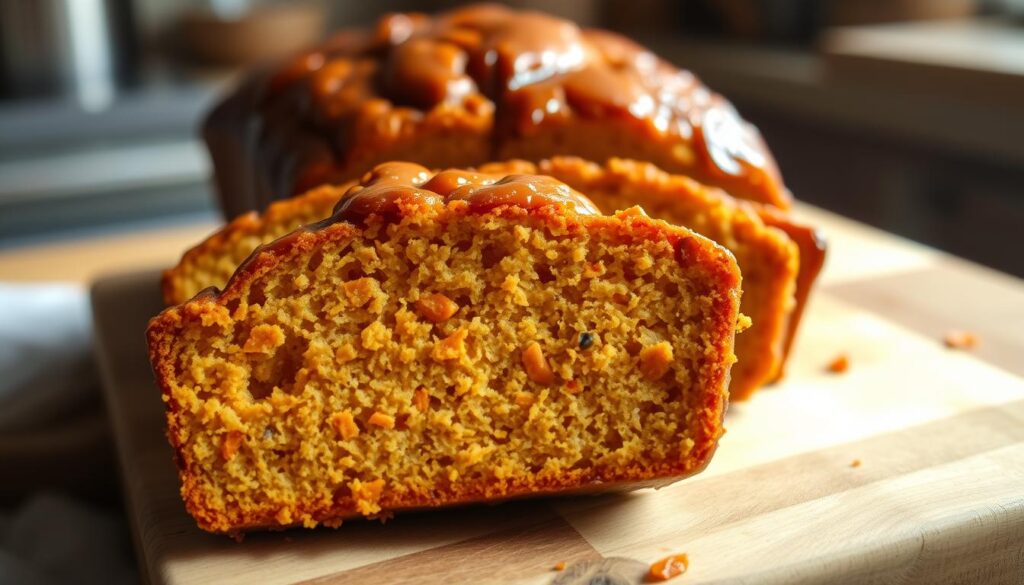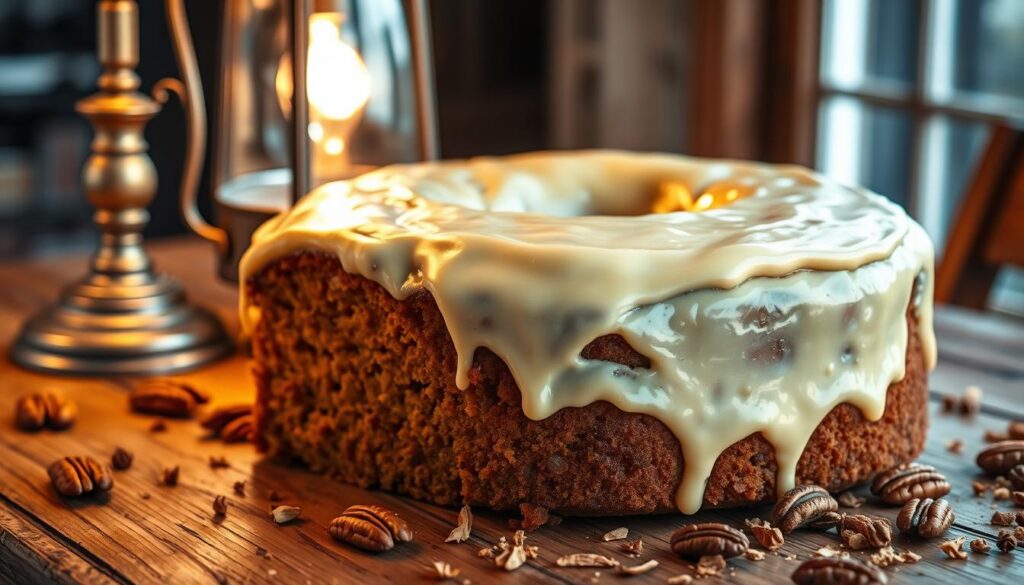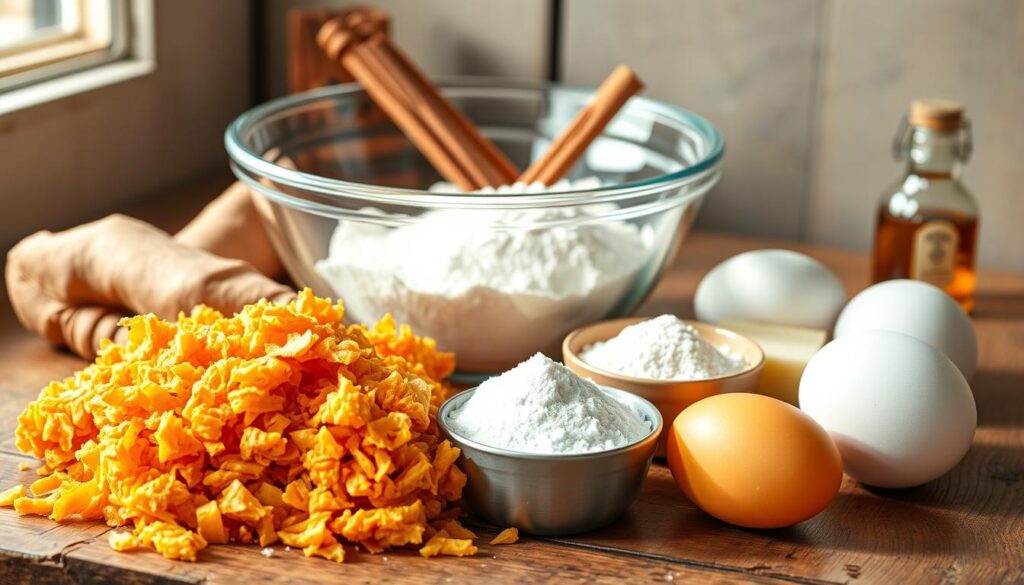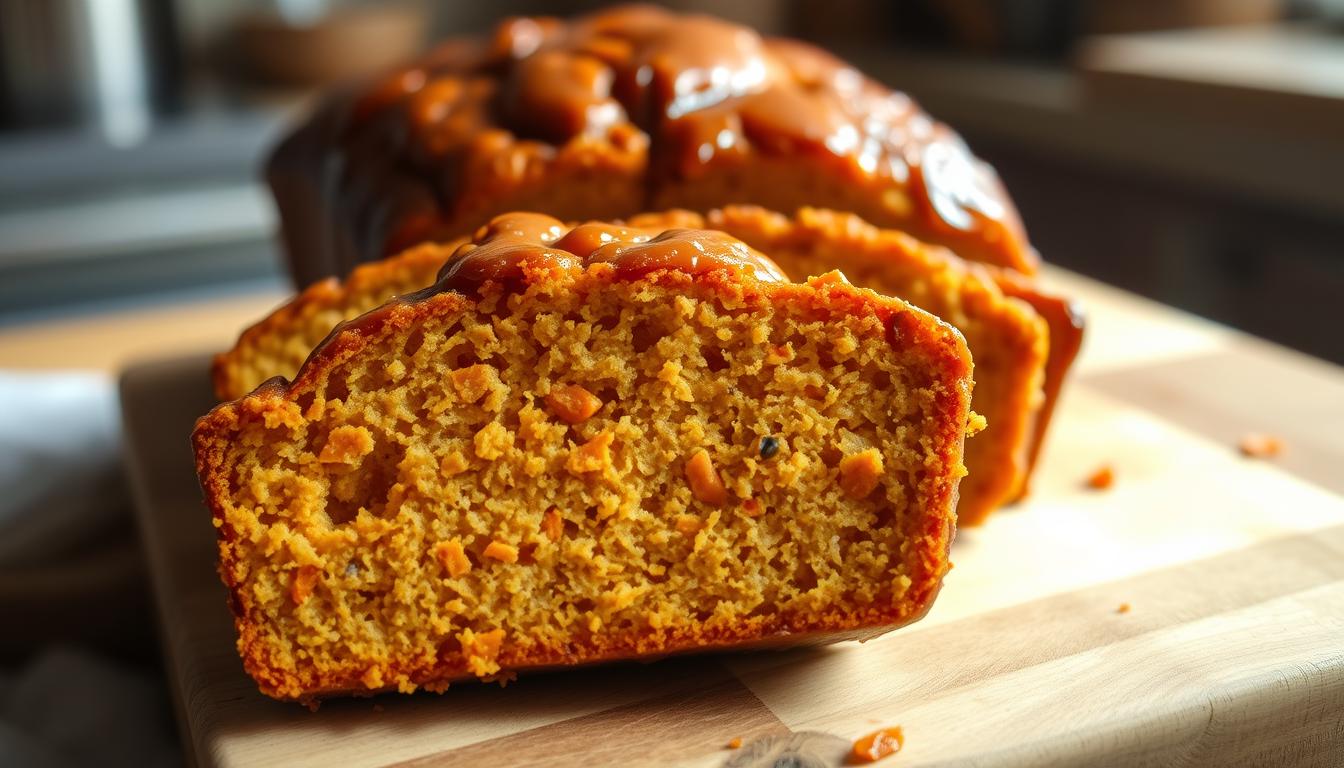
When you enter a Southern kitchen, the scent of sweet potato pound cake greets you. It brings to mind family gatherings and cherished traditions. This Southern baking treasure is more than a dessert; it’s a piece of culinary heritage.
Southern baking is a language of love, passed down through guarded recipes. Each sweet potato pound cake shares a story of comfort and connection. It’s a symbol of warmth and hospitality, enjoyed at family reunions and holiday celebrations across the South.
If you love baking or just want a taste of Southern tradition, this cake is for you. It promises to take you to a world of delicious memories. Get ready to fall in love with a dessert that’s a piece of Southern culture.
Table of Contents
The Rich Heritage of Sweet Potato Pound Cake in Southern Cuisine
Sweet potato pound cake is a delicious example of Southern baking’s creativity. It’s a classic comfort food that brings together a mix of cultural history. This mix comes from recipes passed down through generations of Southern families.

The story of sweet potato pound cake starts in the kitchens of the old South. There, cooks made amazing desserts from simple ingredients. They combined African and European cooking styles, creating a unique recipe that shows the South’s complex culture.
Roots in Antebellum Kitchens
In the 19th century, sweet potatoes were a key ingredient in Southern cooking. Enslaved cooks and plantation workers found creative ways to use them. They made rich, moist cakes that became beloved by families.
- Sweet potatoes were abundant and affordable
- Recipes were passed through oral traditions
- Cooking techniques reflected cultural resilience
Generational Evolution
Each generation of Southern bakers made the sweet potato pound cake their own. They changed recipes to fit new tastes and ingredients. Families kept these recipes alive, linking them to their culinary past.
Cultural Significance
Sweet potato pound cake is more than a dessert; it’s a symbol of Southern hospitality. It stands for community, family, and making something special from simple things. Today, it’s still a treasured part of Southern cooking.
Essential Ingredients for a Perfect Sweet Potato Pound Cake

Making a delicious sweet potato pound cake begins with picking the right ingredients. Your cake’s success depends on quality parts that blend well. This mix creates a moist cake with deep flavors.
The main ingredient is, of course, the sweet potatoes. Choose fresh, vibrant orange sweet potatoes that are firm and without blemishes. They add natural sweetness and a lovely golden color to your cake.
- Fresh sweet potatoes
- High-quality unsalted butter
- Granulated sugar
- All-purpose flour
- Large eggs
- Vanilla extract
The type of butter you choose is key to the cake’s texture. Go for European-style butter with more fat for a richer taste. Make sure all ingredients are at room temperature for smooth mixing and even texture.
Spices are vital for boosting the flavor. Cinnamon, nutmeg, and a pinch of ground ginger can make your cake stand out. They enhance the sweet potatoes’ natural sweetness.
Pro tip: Always use fresh spices and measure them carefully. Old spices can dull the flavors that make this Southern classic unforgettable.
Preparing Your Sweet Potatoes for Baking Success
Creating a delicious sweet potato pound cake starts with the right sweet potato prep. This step is key to making a moist cake that will wow your loved ones. The right method can make your baking journey better and improve your cake’s taste and texture.
Choosing and preparing sweet potatoes is important. Look for ones that are firm, smooth, and without blemishes. The cooking method you pick can greatly affect your cake’s outcome.
Roasting vs. Boiling Methods
Roasting and boiling have their own benefits for sweet potatoes:
- Roasting: It brings out the natural sugars and adds a deep, caramelized taste
- Boiling: It gives a milder taste and a softer texture
Achieving the Perfect Consistency
To get a smooth batter, how you process your sweet potatoes matters. You want a puree that’s smooth and lump-free. This will blend well with your cake mix.
Tips for Proper Mashing
- Let roasted or boiled sweet potatoes cool down completely
- Use a potato masher or food processor for a silky texture
- Strain the puree if there are any lumps left
- Measure carefully to keep the right moisture level
By using these prep methods, your sweet potato pound cake will be moist and full of flavor.
Mastering the Creaming Method for Dense, Moist Texture
Creating a dense loaf cake starts with the creaming method. This technique turns simple ingredients into a moist cake. It’s all about the science behind creaming.
The creaming process mixes softened butter and sugar until it’s light and fluffy. You want to create air pockets for a dense yet tender crumb. The butter should be soft, around 65-70°F.
- Use room temperature butter for best results
- Beat butter and sugar for 3-5 minutes
- Look for a pale, creamy consistency
- Scrape down the bowl periodically
Professional bakers know creaming is key. Start by beating butter until smooth, then add sugar slowly. Patience is crucial – rushing can make the cake dense.
Look for these signs of perfectly creamed butter and sugar:
- Mixture turns pale yellow
- Texture becomes fluffy and increases in volume
- Sugar crystals dissolve completely
- Mixture looks light and creamy
Avoid mistakes like cold butter or overmixing. Your sweet potato pound cake needs gentle care for a velvety texture. It will have everyone asking for seconds.
Mixing Techniques That Guarantee a Velvety Crumb
To make a perfect moist cake, it’s not just about the recipe. The way you mix the ingredients is key. It turns simple ingredients into a delicious dessert.
Baking is a science that needs precision. How you mix the ingredients can affect your cake’s texture.
Proper Ingredient Temperature
Temperature is crucial when mixing your cake batter. Ingredients at room temperature mix better. Cold ingredients can cause texture issues.
- Eggs should sit at room temperature for 30 minutes before mixing
- Butter needs to be soft but not melted
- Dairy products like milk and cream work best when slightly warm
Order of Incorporation
The order in which you add ingredients matters a lot. Bakers know the right order for the best results.
- Cream butter and sugar until light and fluffy
- Add eggs one at a time, fully incorporating each
- Alternate dry ingredients with liquid ingredients
- Fold in mashed sweet potatoes gently
Avoiding Common Mixing Mistakes
Don’t overmix your batter. It can ruin the cake’s texture. Mix gently to keep it tender.
| Mixing Mistake | Potential Consequence | Prevention Tip |
|---|---|---|
| Overmixing | Tough, dense texture | Mix just until ingredients are combined |
| Undermixing | Uneven ingredient distribution | Ensure no flour streaks remain |
| Incorrect temperature | Inconsistent baking | Use room temperature ingredients |
Pro tip: Stop mixing as soon as your batter looks uniform to preserve the cake’s delicate structure.
Baking Tips for the Perfect Golden Crust
To get a perfect golden crust on your sweet potato pound cake, you need to be precise. It’s all about mastering a few key baking techniques. These will turn a good cake into a truly amazing one.
The oven temperature is key for that golden look. Preheat it to 325°F (165°C) for the best results. This temperature helps your cake bake evenly, without burning the edges.
- Position your cake pan in the center of the oven for consistent heat distribution
- Use light-colored metal baking pans to prevent excessive browning
- Rotate the pan halfway through baking to ensure uniform coloring
Don’t just rely on the clock to check if your cake is done. The toothpick test is the best way. Stick a toothpick into the cake’s center. If it comes out clean, with just a few moist crumbs, it’s ready.
To keep your cake’s edges from getting too brown, use cake strips or a foil tent. This method helps prevent over-browning and keeps the cake tender.
After baking, let your sweet potato pound cake cool in the pan for 10-15 minutes. This resting time helps the cake set. It also makes it easier to remove, ensuring a stunning presentation for your fall dessert.
Creating a Complementary Glaze or Frosting
Elevate your sweet potato pound cake into a stunning Thanksgiving treat with the perfect topping. The right glaze or frosting can transform your dessert. It takes your autumnal flavors to the next level of deliciousness.
Choosing the right topping is an art form. It complements the rich, smooth texture of your sweet potato pound cake. Let’s explore some mouthwatering options that will make your dessert truly memorable.
Classic Cream Cheese Frosting
A tangy cream cheese frosting provides the ultimate balance to the sweet potato cake’s richness. Here’s a simple recipe to create the perfect topping:
- 8 oz cream cheese, softened
- 1/2 cup unsalted butter, room temperature
- 4 cups powdered sugar
- 1 teaspoon vanilla extract
Maple Butter Glaze Options
For those seeking an authentic autumnal flavor, a maple butter glaze can be a game-changer. Drizzle this smooth, sweet glaze over your cake to enhance its seasonal appeal.
- Combine 1/4 cup maple syrup
- 2 tablespoons melted butter
- 1 cup powdered sugar
- Whisk until smooth
Seasonal Topping Variations
Experiment with these creative toppings to make your fall dessert truly spectacular:
- Candied pecans for a crunchy texture
- Spiced whipped cream with cinnamon
- Caramel drizzle
- Toasted marshmallow frosting
Each topping brings its own unique character to your Thanksgiving treat. This allows you to customize your sweet potato pound cake to perfection.
Storage Solutions and Make-Ahead Options
Keeping your classic comfort food fresh is key. Your sweet potato pound cake can stay delicious for a long time. Just follow these expert tips for storing it.
Room Temperature Storage
For a short time, keep your cake at room temperature. Wrap it tightly in plastic wrap or use an airtight container. It will stay fresh for 2-3 days when covered right.
Refrigeration Strategies
Refrigeration is best for longer storage. Wrap the cake in plastic wrap, then foil. This way, your cake can last up to a week in the fridge, staying moist.
Freezing Techniques
- Wrap individual slices in plastic wrap
- Place wrapped slices in freezer-safe containers
- Label with the date of freezing
- Freeze for up to 3 months
Thawing Process
Ready to thaw your frozen cake? Here’s how:
- Remove from freezer
- Let sit at room temperature for 1-2 hours
- Unwrap carefully to prevent moisture buildup
- Optional: Warm slightly in the oven for renewed freshness
Make-Ahead Recommendations
Make the batter ahead of time. Store it in an airtight container in the fridge for up to 24 hours before baking.
| Storage Method | Duration | Best For |
|---|---|---|
| Room Temperature | 2-3 days | Immediate consumption |
| Refrigeration | Up to 1 week | Extended freshness |
| Freezing | Up to 3 months | Long-term storage |
Pro tip: Always let your sweet potato pound cake cool completely before storing. This prevents condensation and keeps it perfect.
Seasonal Variations and Flavor Enhancements
Turn your classic sweet potato pound cake into a stunning fall dessert. It will capture the essence of autumn. With a few tweaks, this traditional treat becomes a showstopper for Thanksgiving. It will impress your guests and satisfy your taste buds.
Try these exciting flavor variations to make your pound cake special:
- Nutty Delights: Add chopped pecans or walnuts for a rich, crunchy texture
- Dried Fruit Twist: Mix in dried cranberries or chopped dates for a sweet burst
- Chocolate Lover’s Dream: Include dark chocolate chips for a decadent twist
Seasonal spices can greatly enhance your cake’s autumnal flavor. Consider these warm additions:
- Ground cinnamon
- Nutmeg
- Ginger
- Cardamom
“The secret to an unforgettable fall dessert is layering complex, warm flavors that speak to the season.” – Southern Baking Experts
Want to make your cake extra special for Thanksgiving? Try these creative enhancements:
- Sprinkle a crunchy streusel topping before baking
- Add roasted pumpkin puree to the batter
- Drizzle with a maple cream cheese glaze
Experiment with different baking pans for unique presentations. A bundt pan adds elegance, while mini cake pans offer individual servings. Your sweet potato pound cake will be the highlight of any autumn celebration!
Conclusion
Your sweet potato pound cake journey is more than just a recipe. It’s a deep dive into southern baking traditions that connect families across generations. This classic dessert is not just about ingredients. It’s about the heritage and love shared in family kitchens across the American South.
Every slice of sweet potato pound cake has a story. It’s about technique, passion, and cultural importance. By following the guide, you’ll turn a simple sweet potato into a stunning dessert. This dessert captures the heart of southern hospitality.
Whether for a family event, holiday, or a cozy afternoon tea, your cake will be a hit. Southern baking is about making moments, sharing memories, and keeping traditions alive. With love and practice, your pound cake will become a special part of your story.
Embrace the warmth and soul of this beloved dessert. Your sweet potato pound cake is a bridge to a rich culinary tradition. It continues to inspire and delight home bakers in the United States.
FAQ
What makes sweet potato pound cake different from other pound cakes?
Sweet potato pound cake is special because of its moist texture and rich taste. Sweet potatoes add natural sweetness and a vibrant orange color. They also make the cake incredibly moist, setting it apart from regular pound cakes.
The addition of sweet potatoes brings both nutrition and a unique autumnal flavor. This makes the cake a beloved Southern classic.
Can I make this cake if I’m not an experienced baker?
Yes, you can! Sweet potato pound cake is easy for beginners. Its dense texture means it’s forgiving of small mixing errors. Just follow the recipe carefully, measure ingredients right, and mix well.
You’ll be able to make a delicious cake even if you’re new to baking.
How long will sweet potato pound cake stay fresh?
Your cake will stay fresh for 3-4 days at room temperature in an airtight container. If you refrigerate it, it can last up to a week. For longer storage, freeze it for 2-3 months.
Wrap it tightly in plastic wrap and then aluminum foil to keep it moist and flavorful.
Can I substitute canned sweet potatoes for fresh?
You can use canned sweet potatoes if fresh ones are not available. Drain them well and pat dry to avoid excess moisture. Choose unsweetened canned sweet potatoes and avoid those in syrup.
Fresh sweet potatoes will give your cake the best flavor and texture, though.
Are there any gluten-free variations of this recipe?
Yes! To make a gluten-free version, use a gluten-free flour blend instead of all-purpose flour. Look for a blend that includes xanthan gum. Or, mix almond flour with gluten-free flour for a dense texture.
This way, the cake remains dense and is safe for those with gluten sensitivities.
What are the best spices to use in sweet potato pound cake?
Classic fall spices like cinnamon are essential. You can also add nutmeg, ginger, and cloves for a warm flavor. Many recommend using a pumpkin pie spice blend for a balanced taste.
This blend usually includes these spices in the right amounts, enhancing the sweet potato’s natural sweetness.
How can I tell when the sweet potato pound cake is fully baked?
Check if the cake is done by using the toothpick test. Insert a toothpick into the center – it should come out clean or with a few moist crumbs. The edges will also pull away from the pan.
The cake will have a golden-brown color. Use an instant-read thermometer to check the internal temperature, aiming for 210-215°F.

